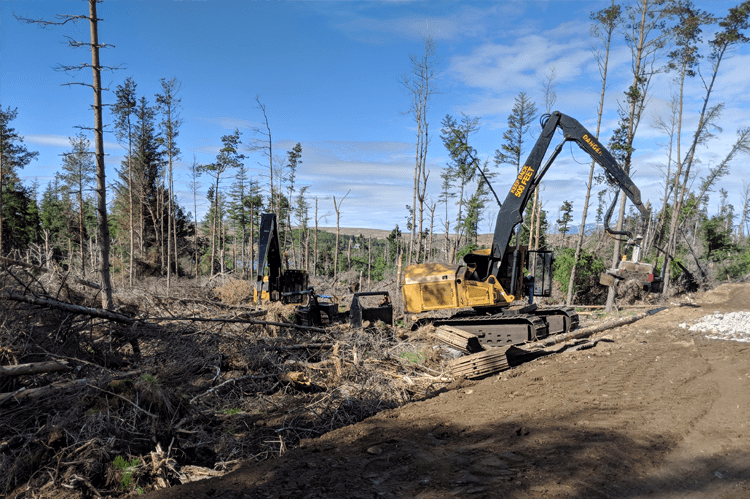Tree Felling Permission & Windblown Trees
Download a pdf copy of this Forestry Information Note
Strong winds can cause significant damage and disruption, leaving landowners to face the challenge of clearing the debris. For anyone facing the clearance of windblown trees, there should be two primary considerations to address prior to any action; Safety, and Felling Permission.
Safety:
Felling trees and working with chainsaws is inherently dangerous, but at no time more so than working on storm-damaged trees and forests. Windblown trees are especially hazardous, as they may be under significant compression/tension forces with stored kinetic energy, may contain suspended debris such as large limbs and crowns that are not visible from the ground, or may be supporting/tangled up in other trees (hung-up). There is also the potential that power lines, phone cables, water and gas mains may also have been affected by falling trees/lifting root plates, and as such, health and safety should be absolutely paramount when approaching windblown trees.
In response to Storm Arwen we held a webinar that focused on the legalities and safety considerations required when clearing windblown trees. Watch the recording above.
The removal of windblown trees should only ever be undertaken by trained, qualified and experienced professionals who have the right tools and insurance for the task in hand. For areas that have been windblown that are awaiting assessment and clearance, erect signage and barrier tape to exclude access until storm-damaged trees and areas can be made safe.
Felling Permission:
Under the Forestry and Land Management (Scotland) Act 2018, it is an offence to fell trees without first getting felling permission from Scottish Forestry. The clearance of windblown trees requires a Felling Permission (previously known as a Felling Licence), unless you qualify for an exemption;
- Trees pose an immediate danger to people, property, or infrastructure
- Windblown trees that are blocking roads
Full list of exemptions found in links below;
If you are claiming exemption from felling permission (trees posing an immediate danger), the burden of proof to demonstrate this exemption lies with the person claiming it. We strongly advise that you take multiple photographs of any situation where you are claiming exemption and record decisions made in your risk assessment and method statement for the task, and retain these records for at least 3 years.
If you require a felling permission, there is guidance for applicants available on Scottish Forestry’s website here: Scottish Forestry– Felling Permission
Alternatively, speak to your local Scottish Forestry Woodland Officer or Forestry Agent.
Felling trees (or clearing windblown trees) without valid exemption or Felling Permission can result in prosecution, a criminal record and a fine of up to £5,000 per tree felled. Failure to secure proper permissions prior to felling can result in prosecution/criminal records/fines for not only the landowner, but anyone else involved too.
No person should approach trees in contact with power lines, or fell trees with the potential to hit powerlines, even if these lines are perceived to be “dead” or lying on the ground. Cables can be re-energised at any point or can even remain live whilst lying on the ground, so should only be tackled by authorised utilities staff. If you see a dangerous fault on the power line network such as branches or trees tangled in overhead lines, keep a safe distance and call 105.

Key Messages
- Safety should always be your number one priority. If in doubt, seek professional assistance.
- Felling Permission is required for all trees* in Scotland including windblow, with substantial penalties for illegal felling. *Limited exemptions apply.
- If claiming an exemption, collect plenty of photographic evidence and retain this for at least 3 years.
- Do not approach damaged power lines or trees/branches in contact with overhead lines– call 105 and keep a safe distance.
Sign up to the FAS newsletter
Receive updates on news, events and publications from Scotland’s Farm Advisory Service
